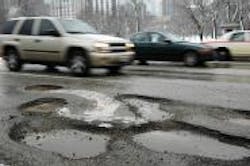Maybe LaHood should drive down the highway
Under questioning from Sen. Kit Bond (R-MO) last week, U.S. Transportation Secretary Ray LaHood defended the state of our roads in the U.S.
Bond, who sits on the Senate’s transportation appropriates subcommittee, was questioning the Administration’s plan to spend $527 million for “livable communities.” According to the American Assn. of State Highway and Transportation Officials (AASHTO), Bond wondered if DOT was siphoning money from road improvement efforts to fund this new initiative.
Perhaps LaHood needs to spend more time on our highways and less time in Washington.
A 2009 study by the Pacific Institute for Reasearch & Evaluation (PIRE) found that crashes on U.S. highways cost American businesses $22 billion annually, in addition to a $12 billion cost to government and $12 billion medical bills.
“The cost of crashes involving deficient roadway conditions dwarf the costs of crashes involving alcohol, speeding, or failure to wear a safety belt,” said Ted Miller, Ph.D., with the Beltsville, MD-based Pacific Institute for Research & Evaluation (PIRE), in testimony before the U.S. Senate Environment and Public Works Committee.
In all, the report, On a Crash Course: The Dangers and Health Costs of Deficient Roadways, says deficient roadway conditions cost $217 billion a year.
Numerous organizations have come out against the livable communities plan. Anything that diverts funding from solving our nation’s infrastructure woes – upon which, at last check, the majority of goods move in this country – needs to be closely examined.
Livable communities sound really good, unless you expect your local grocery store to have milk on its shelves when you need it. We’ve long since passed the time when milk is delivered via horse-and-buggy.
I’m sure LaHood is right. Compared to other nations, we probably do have a state-of-the-art transportation system. That doesn’t mean we have to settle.
